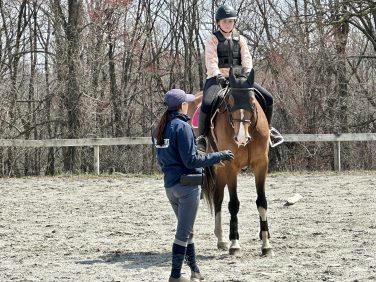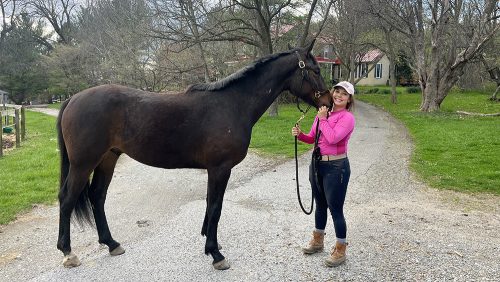Is this what a heyday feels like?
About nine months ago I was talking with a fellow CANTER volunteer about all of the exciting things happening in our all-encompassing world of Thoroughbreds, and I remember saying “Do you feel that? Do you feel the earth starting to rumble? It’s time, baby!”
It’s totally time.
OTTBs are everywhere you look right now! There are horse shows dedicated to them, ground-breaking awards programs being put in place, magazine articles, blogs, professional-horseman testimonials, horse shows at the racetracks, trainer contests, books being written, documentaries being filmed, and more and more horses getting new homes.
There aren’t enough hours in the day to read all of the cool stuff being put out there and the feeling of anxiety I get from trying to get it all read is smothered by the pride I feel watching these athletes get the recognition they deserve. I feel sort of like a mom who shoved her talented quirky kid out in front of Simon Cowell, and he totally rocked it.
But the ex-racehorse as sport-horse thing isn’t new. They’ve been around forever, and the people who have retrained, competed and loved them have always known the secret—that they are, despite their initially low price tags—truly priceless and competitive on the world stage.
ADVERTISEMENT
What is changing is public perception (OMG! RACEHORSE EQUALS CRAZY AND WILL KILL YOU DEAD IF THEY DON’T EAT YOU FIRST!) and public support by way of horse shows, OTTB-only classes, OTTB competitions, etc., and watching this all unfold is pretty cool.
I just finished up the list of eligible competitors for CANTER’s second annual award for highest placed race-bred horse at Rolex Kentucky this year. There are 30 horses eligible! 30. Thirty out of almost 70 entries—bred for the track but ended up as eventers. Not just eventers, the top of the top of eventing—four-star eventers.
But we can do more to promote the Thoroughbred as sport horse. Digging up all of the information is a bit difficult and involves many hours of checking the U.S. Equestrian Federation, Jockey Club and Equibase, emailing owners and former owners, and sometimes getting creative.
It made me realize that with all of the prize money and awards showing up around the country, wouldn’t it be great if USEF, the U.S. Eventing Association and U.S. Dressage Federation etc. had a few optional pieces of information to input into the Horse Registration Databases? I’d love to see a checkbox indicating whether a horse raced (Yes, No, Unsure), and a place for Jockey Club Name. Someone make that happen, will ya?
Something else I’ve been pondering, and CANTER Mid Atlantic is putting in place, came to me when I was lucky enough to be walking around the Burghley CCI**** course this past year, looking through the program. At one point I remember saying “OK, what the heck are these Clifton and Fernhill people doing right? Their horses are everywhere, talk about successful breeding programs!”
Pretty sure I slapped my head a few seconds later when it dawned on me that…er…they aren’t breeding programs. Derp. They are marketing programs, and a lot of the horses they are marketing are good old -ashioned ex-racehorses. It’s easy to identify a horse that came out of these programs because they have the surname in front of them—much like breeding programs do.
ADVERTISEMENT
The epiphany I felt at that moment was like getting hit by a train. Groups who are retraining and getting Thoroughbreds out into the show world need to do a better job announcing their roots, and what better way to do it than right there in the event or show program, in their very name?
So, that’s what CMA is doing, and we hope others will follow suit. We’re asking anybody who obtains a horse from our CANTER-owned program—those horses we take in, rehabilitate, retrain and rehome—to sport the initials “CMA” in front of their name—whatever name they choose for that horse. That way we don’t have to ask that people keep names like “Doe Doe Bird” (actual former name of a Thoroughbred entered at Rolex!), but they are still recognizable as a former racehorse that came through our program.
It will start slow, with a few CMA horses here and there, but it will grow—much like the recognition OTTBs are getting everywhere in the country. You’ll see one at your local event, and you’ll maybe see two next year.
But in a few years? You’ll see one at Rolex Kentucky, and one at the Olympic Games, and you will want to know where to get one just like it. And you know what? You’ll totally know where to go. How fun to have 50 horses entered at Rolex Kentucky or the FEI World Equestrian Games with names starting with RR (ReRun), CTR (CANTER), NV (New Vocations), TRF (Thoroughbred Retirement Foundation), TPR (Thoroughbred Placement and Rescue), FF (Friends of Ferdinand) etc?
I think it would be pretty badass. Someone make that happen too, will ya?
Allie Conrad is executive director of CANTER Mid Atlantic, which provides retiring Thoroughbred racehorses with opportunities for new careers. Allie founded the organization in 1999 at Charles Town Racetrack (W.V.) after purchasing her beloved Thoroughbred Phinny, who had more than 60 starts at Charles Town, at the infamous New Holland Auction in Pennsylvania. A resident of Southern Pines, N.C., Allie also works full time as a project manager for a Washington, D.C., consulting firm. You can learn more about CANTER Mid Atlantic on their website, www.canterusa.org/midatlantic.















